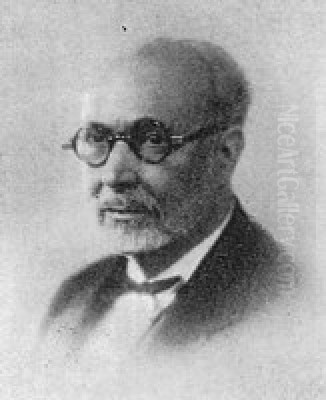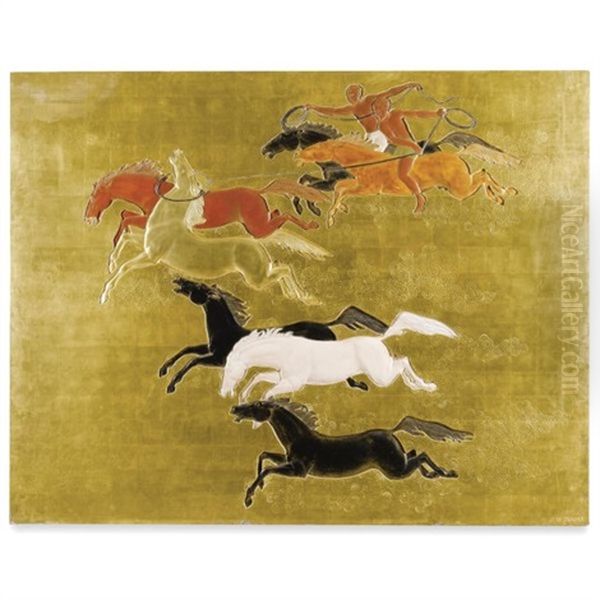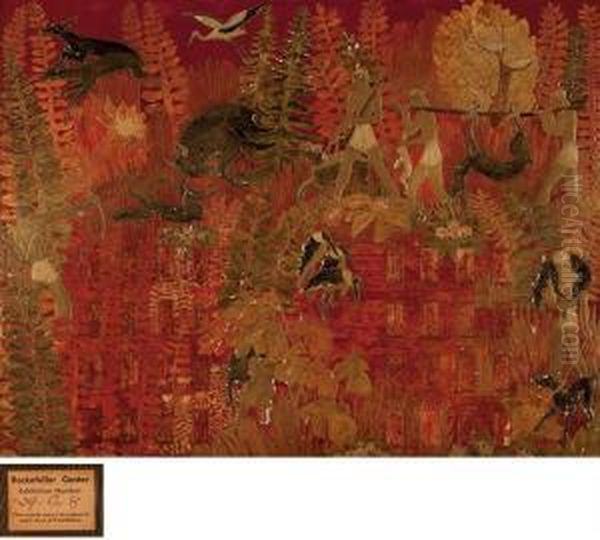Introduction: A Versatile Artisan of an Era

Jean Dunand, born Jules-John Dunand in Petit-Lancy, Switzerland (1877-1942), stands as a towering figure in the landscape of 20th-century decorative arts. His name is synonymous with the elegance, innovation, and luxurious craftsmanship of the Art Deco period. Though Swiss by birth, Dunand became a quintessential Parisian artist, mastering multiple disciplines including sculpture, metalwork, and most famously, the demanding art of lacquer. His unique ability to synthesize ancient Eastern techniques with the modernist aesthetics of his time cemented his legacy as one of the most important and versatile artists of his generation. Dunand's journey from a promising sculptor to the preeminent master of Art Deco lacquer is a story of dedication, cross-cultural exchange, and relentless artistic exploration.
Early Life and Artistic Formation
Born into an environment touched by craft – his father was a goldsmith – Dunand's artistic inclinations were nurtured early. He pursued formal training at the School of Industrial Arts in Geneva, focusing initially on sculpture and metalworking. This foundational education provided him with a strong technical base and an appreciation for material and form. Seeking broader horizons, the ambitious young artist moved to Paris in 1897, the vibrant heart of the European art world at the turn of the century.
In Paris, Dunand further honed his sculptural skills, studying at the National School of Decorative Arts and significantly, apprenticing in the studio of the respected sculptor Jean-Auguste Dampt. Dampt, associated with the Symbolist movement and Art Nouveau aesthetics, likely exposed Dunand to intricate craftsmanship and the integration of art into everyday objects. This period was crucial, immersing Dunand in the dynamic Parisian art scene where Neoclassicism coexisted with emerging Modernist ideas, influencing his evolving artistic sensibilities. His initial focus remained on sculpture and particularly dinanderie, the traditional craft of shaping and decorating non-precious metals like copper and brass through hammering.
The Transformative Power of Lacquer

A pivotal moment in Dunand's career occurred around 1912. Seeking to expand his technical repertoire, he encountered Seizō Sugawara, a Japanese master lacquer artist living in Paris. A unique arrangement ensued, often described as a "skill exchange": Dunand taught Sugawara the techniques of dinanderie and metal patination, while Sugawara initiated Dunand into the complex and time-honored secrets of traditional Japanese lacquerwork, particularly the use of urushi, derived from the sap of the lacquer tree.
This encounter was transformative. Mastering urushi lacquer, a painstaking process involving numerous layers, careful drying conditions, and polishing, opened entirely new avenues for Dunand's artistic expression. It allowed him to imbue surfaces with unparalleled depth, luminosity, and resilience. He quickly recognized the potential of combining the rich, lustrous surfaces of lacquer with his existing expertise in metalwork and design, setting him on a path that would define his mature career and distinguish him within the Art Deco movement. He established his own workshop in Paris, which would become a hub for producing exquisite lacquer and metal objects.
Mastery of Materials: Lacquer and Dinanderie
Jean Dunand's renown rests significantly on his exceptional command over his chosen materials, primarily lacquer and metal. His dinanderie work, often forming the structural basis for his vases and other objects, displayed a sculptor's sensitivity to form and volume, enhanced by sophisticated patinas. However, it was his application of lacquer that truly set him apart. He didn't merely coat surfaces; he integrated lacquer into the very essence of his designs, exploring its full potential for color, texture, and inlay.
He became particularly famous for incorporating coquille d'œuf (eggshell inlay) into his lacquer work. This meticulous technique involved embedding crushed eggshells into the wet lacquer, creating intricate mosaic-like patterns with a unique cracked texture and subtle luminosity that contrasted beautifully with the smooth, deep lacquer grounds, often black or red. This became one of his signature techniques, adding a layer of preciousness and visual complexity to his pieces.
Furthermore, Dunand expertly combined lacquer with metal, inlaying metal elements into lacquered surfaces or applying lacquer directly onto metal forms. This fusion created striking contrasts between the cool precision of metal and the warm depth of lacquer. His technical innovations extended to experimenting with different lacquer formulas, including attempts at creating more durable or even fire-resistant finishes, showcasing his relentless drive to push the boundaries of his craft. His workshop employed numerous artisans under his direction to realize his ambitious designs.
Defining the Art Deco Aesthetic

Jean Dunand was not merely a participant in the Art Deco movement; he was one of its defining practitioners. His work embodies the core tenets of the style: a fascination with geometric forms, a penchant for stylized representation over naturalism, the use of luxurious and exotic materials, and an embrace of modernity tempered by a deep respect for craftsmanship. His designs often featured streamlined shapes, zigzags, chevrons, stepped forms, and stylized floral or figurative motifs.
His aesthetic drew from a diverse range of influences. The geometry and abstraction evident in his work show kinship with Cubism, while the stylized figures and motifs sometimes echo influences from ancient Egyptian, African, and East Asian art – sources frequently mined by Art Deco designers. There's a palpable tension in his work between the discipline of geometric patterns and the sensuousness of the materials themselves. Bold color combinations, often featuring black, red, gold, and silver, contributed to the dramatic and sophisticated visual impact characteristic of the era.
Dunand applied this distinctive style across an impressive array of objects. While perhaps best known for his monumental screens and vases, he also designed furniture, jewelry, smoking accessories, powder boxes, picture frames, and even undertook portraiture in lacquer. His ability to adapt his aesthetic to different scales and functions underscores his versatility and his central role in shaping the visual language of Art Deco. He collaborated with other leading figures, ensuring his style permeated the most fashionable interiors and collections of the time.
Signature Works and Monumental Commissions
Jean Dunand's oeuvre includes numerous iconic pieces that exemplify his mastery. Among his most celebrated works are his large-scale decorative screens. These multi-paneled works served as canvases for his most ambitious lacquer compositions, often featuring complex figurative scenes, abstract patterns, or stylized natural motifs like the famous "Tree of Life" design. These screens were highly sought after for luxurious interiors, functioning as both room dividers and major artistic statements.
Perhaps his most monumental and widely recognized commission was for the legendary French ocean liner, the SS Normandie, launched in 1935. Considered a floating palace of Art Deco design, the Normandie featured interiors by France's leading artists and decorators. Dunand was entrusted with creating vast lacquer panels for several key spaces, most notably the enormous murals depicting "La Conquête du Cheval" (The Conquest of the Horse) and "Chasse" (The Hunt) for the walls of the first-class smoking room. These panels, executed on a grand scale using lacquer, gold leaf, and potentially other techniques, were masterpieces of stylized figuration and decorative power. Anecdotes suggest Dunand worked tirelessly on this commission, sacrificing sleep and potentially his health to meet the demanding schedule, a testament to his dedication.
Beyond the Normandie, Dunand contributed decorations to other prestigious ocean liners like the SS Ile-de-France and the SS Atlantique. His vases, often large in scale and featuring bold geometric patterns in dinanderie combined with lacquer and eggshell inlay, are also highly representative of his work and are prized by collectors. He also created striking lacquer portraits, including famous depictions of contemporaries like the entertainer Josephine Baker, capturing their likeness with stylized elegance.
Collaborations and Contemporary Circles
Jean Dunand operated within a vibrant network of artists, designers, and patrons in Paris. His collaboration with Seizō Sugawara was foundational, but his interactions extended throughout the creative milieu of the time. He worked closely with prominent furniture designers and decorators, most notably Émile-Jacques Ruhlmann, perhaps the most celebrated ébéniste (cabinetmaker) of the Art Deco era. Dunand often provided lacquer panels or elements to be incorporated into Ruhlmann's luxurious furniture pieces, a partnership that resulted in some of the period's most exquisite creations.
His skills were also sought after in the world of fashion. A notable collaboration occurred in 1931 with the avant-garde couturière Elsa Schiaparelli. Dunand applied his technical ingenuity to textiles, helping Schiaparelli realize innovative pleated fabric designs inspired by classical Greek drapery, demonstrating his adaptability across different media.
Dunand exhibited his work alongside other leading figures of the decorative arts scene. His contemporaries and peers included masters like René Lalique, renowned for his glass and jewelry; Edgar Brandt, a virtuoso of wrought iron; Gustave Miklos and Jean Lambert-Rucki, sculptors who also worked in decorative media; Jean Goulden, known for his champlevé enamel work; and Eileen Gray, another innovator in furniture and lacquer, though with a distinct modernist style. He would have also been aware of, and exhibited alongside, designers like Paul Follot and Maurice Dufrène. His participation in major exhibitions placed him in direct dialogue with these and other key figures like the glass artist Maurice Marinot. His early mentor, Jean-Auguste Dampt, remained a respected figure, and Dunand also associated with artists like François-Louis Schmied, known for his bookbinding and graphic arts, through figures like Paul Jove.
His patrons included discerning collectors who appreciated the quality and modernity of his work, such as the American industrialist Solomon R. Guggenheim, whose collection would form the basis of the Guggenheim Museum. These connections highlight Dunand's integration into the highest echelons of the Art Deco world.
Exhibitions and International Acclaim
Jean Dunand's reputation was built not only on the quality of his work but also on its visibility through major national and international exhibitions. He was a regular participant in the Salons of the Société des Artistes Décorateurs in Paris, crucial showcases for new trends in decorative arts. His international breakthrough arguably came with the landmark 1925 Exposition Internationale des Arts Décoratifs et Industriels Modernes in Paris. This exhibition, which retrospectively gave the Art Deco movement its name, was a defining moment, and Dunand's contributions were widely admired, solidifying his position as a leading figure.
He continued to exhibit prominently throughout the late 1920s and 1930s, participating in subsequent major Paris exhibitions, including the Colonial Exposition of 1931 and the International Exposition of Arts and Techniques in Modern Life in 1937. His work also traveled abroad, gaining recognition in the United States and the United Kingdom. His participation in the 1939 New York World's Fair further cemented his international stature.
This consistent presence in major exhibitions ensured that his innovative work reached a wide audience of designers, critics, and collectors. Today, his pieces are held in the permanent collections of major museums worldwide, including the Metropolitan Museum of Art in New York, the Musée d'Orsay and the Musée des Arts Décoratifs in Paris, and the Musée d'Art et d'Histoire in his native Geneva, to which he generously donated works during his lifetime. This institutional recognition underscores his historical importance and enduring artistic value.
The Evolution of a Distinctive Style
Jean Dunand's artistic journey reflects a clear evolution, moving from his initial training in more traditional sculptural and metalworking techniques towards a highly personal and modern style. His early works in dinanderie show the influence of Art Nouveau's sinuous lines and natural forms, likely absorbed during his studies and apprenticeship with Dampt. However, even in this early phase, a tendency towards simplification and strong composition was evident.
The encounter with Japanese lacquer marked a decisive shift. While embracing this ancient technique, Dunand did not simply imitate traditional Japanese styles. Instead, he adapted the medium to express contemporary European aesthetics. The influence of Cubism, with its fragmented forms and geometric underpinnings, became increasingly apparent in his compositions during the 1910s and early 1920s. He translated these modernist principles into the language of lacquer and metal, creating dynamic surfaces patterned with abstract shapes and stylized figures.
By the mid-1920s, his signature Art Deco style had fully matured. It was characterized by a sophisticated balance between geometric rigor and decorative richness, bold color contrasts, the innovative use of materials like eggshell, and flawless execution. His work from this period, including the Normandie commissions, represents the pinnacle of his achievement and embodies the spirit of high Art Deco. In his later career, while remaining true to his core aesthetic, he continued to explore variations in form and technique, maintaining an exceptional standard of craftsmanship until his death in 1942.
Legacy and Enduring Influence
Jean Dunand's legacy is multifaceted. He is remembered as one of the undisputed masters of Art Deco, an artist whose work epitomizes the elegance, luxury, and innovative spirit of the era. His technical virtuosity, particularly in the demanding art of lacquer and the craft of dinanderie, remains awe-inspiring. He successfully bridged cultural divides, integrating the ancient traditions of Japanese lacquer into the mainstream of modern Western design, enriching both in the process.
His influence extended beyond his own creations. Through his collaborations, his teaching (he trained artisans in his workshop, including his son Bernard Dunand), and the widespread exhibition of his work, he helped shape the course of 20th-century decorative arts. His innovative use of materials, particularly the coquille d'œuf technique, inspired other artists and remains a hallmark of his production. The sheer range of his output – from monumental murals and screens to intricate jewelry and boxes – speaks to his remarkable versatility and ambition.
Today, Jean Dunand's works are highly coveted by collectors and institutions, recognized as prime examples of Art Deco at its most refined and technically accomplished. He stands as a testament to the power of dedication, the importance of cross-cultural exchange, and the enduring beauty that can be achieved when masterful craftsmanship is wedded to a bold artistic vision. His name remains inextricably linked with the glamour and sophistication of a defining moment in modern design history.